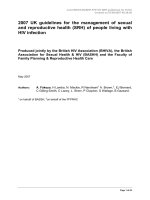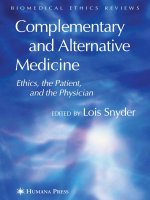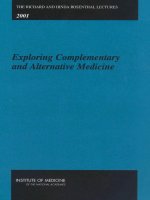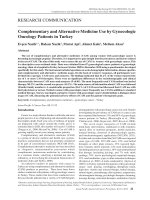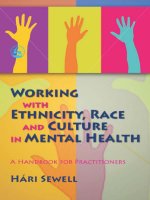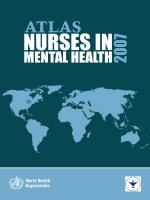Complementary and Alternative Treatments in Mental Health Care doc
Bạn đang xem bản rút gọn của tài liệu. Xem và tải ngay bản đầy đủ của tài liệu tại đây (3.97 MB, 505 trang )
Complementary
and Alternative
Treatments in
Mental Health
Care
This page intentionally left blank
Washington, DC
London, England
Complementary
and Alternative
Treatments in
Mental Health
Care
Edited by
James Lake, M.D.
David Spiegel, M.D.
Note: The authors have worked to ensure that all information in this book is
accurate at the time of publication and consistent with general psychiatric and
medical standards, and that information concerning drug dosages, schedules, and
routes of administration is accurate at the time of publication and consistent with
standards set by the U.S. Food and Drug Administration and the general medical
community. As medical research and practice continue to advance, however,
therapeutic standards may change. Moreover, specific situations may require a
specific therapeutic response not included in this book. For these reasons and
because human and mechanical errors sometimes occur, we recommend that
readers follow the advice of physicians directly involved in their care or the care
of a member of their family.
Books published by American Psychiatric Publishing, Inc., represent the views
and opinions of the individual authors and do not necessarily represent the pol-
icies and opinions of APPI or the American Psychiatric Association.
If you would like to buy between 25 and 99 copies of this or any other APPI
title, you are eligible for a 20% discount; please contact APPI Customer Service
at or 800-368-5777. If you wish to buy 100 or more copies of
the same title, please e-mail us at for a price quote.
Copyright © 2007 American Psychiatric Publishing, Inc.
ALL RIGHTS RESERVED
Manufactured in the United States of America on acid-free paper
1009080706 54321
First Edition
Typeset in Adobe’s Cosmos and Bembo.
American Psychiatric Publishing, Inc.
1000 Wilson Boulevard
Arlington, VA 22209-3901
www.appi.org
Library of Congress Cataloging-in-Publication Data
Complementary and alternative treatments in mental health care / edited by
James Lake, David Spiegel. — 1st ed.
p. ; cm.
Includes bibliographical references and index.
ISBN 1-58562-202-8 (pbk. : alk. paper)
1. Psychiatry. 2. Mental health services. 3. Mental illness—Alternative treat-
ment. I. Lake, James, 1956– . II. Spiegel, David, 1945– .
[DNLM: 1. Mental Disorders—therapy. 2. Complementary Therapies.
WM 400 C7366 2006]
RC460.C66442 2006
616.89'1—dc22
2006025873
British Library Cataloguing in Publication Data
A CIP record is available from the British Library.
For my mother,
Ellen T. Lake,
and in memory of my father,
Willis W. Lake
J.L.
For my wife,
Helen,
and our children,
Julia and Dan
D.S.
This page intentionally left blank
Contents
Contributors. . . . . . . . . . . . . . . . . . . . . . . . . . . . . . . . . . . . . . .xi
Preface . . . . . . . . . . . . . . . . . . . . . . . . . . . . . . . . . . . . . . . . . . xv
David Spiegel, M.D.
Introduction . . . . . . . . . . . . . . . . . . . . . . . . . . . . . . . . . . . . . .xix
James Lake, M.D.
I
Background Issues
1 Complementary and Alternative Treatments in Mental
Health Care: Overview and Significant Trends . . . . . . . . . . 3
James Lake, M.D.
David Spiegel, M.D.
2 Legal, Regulatory, and Ethical Issues . . . . . . . . . . . . . . . . . 21
Michael H. Cohen, J.D.
Ronald Schouten, M.D., J.D.
3 Patient Safety . . . . . . . . . . . . . . . . . . . . . . . . . . . . . . . . . . . . . 37
Brian J. Ellinoy, Pharm.D.
James Lake, M.D.
Christopher Hobbs, L.Ac.
4 Integrative Approaches . . . . . . . . . . . . . . . . . . . . . . . . . . . .63
James Lake, M.D.
II
Review of the Evidence and Clinical Guidelines
Nonconventional Biological Treatments
5 Western Herbal Medicines . . . . . . . . . . . . . . . . . . . . . . . . . 87
Roberta Lee, M.D.
Pamela S. Yee, M.D.
Grace Naing, M.D.
6 Nutritional Supplements . . . . . . . . . . . . . . . . . . . . . . . . . . . 115
Janet E. Settle, M.D.
7 Omega-3 Essential Fatty Acids. . . . . . . . . . . . . . . . . . . . . .151
James Lake, M.D.
8 Chinese Medical Treatments . . . . . . . . . . . . . . . . . . . . . . 169
Julia Thie, L.Ac., Dipl.Ac., Dipl.CH.
9 Homeopathy . . . . . . . . . . . . . . . . . . . . . . . . . . . . . . . . . . . 195
Iris R. Bell, M.D., M.D.(H.), Ph.D.
Pamela A. Pappas, M.D., M.D.(H.)
10 Ayurvedic Treatments . . . . . . . . . . . . . . . . . . . . . . . . . . . . 225
Sudha Prathikanti, M.D.
Lifestyle and Women’s Issues
11 Nutrition . . . . . . . . . . . . . . . . . . . . . . . . . . . . . . . . . . . . . . . 275
Melanie Hingle, M.P.H., R.D.
12 Physical Activity, Exercise, and Mental Health . . . . . . . . 301
Robert B. Lutz, M.D., M.P.H.
13 Integrative Medicine Treatments for
Depression in Women. . . . . . . . . . . . . . . . . . . . . . . . . . . . 321
Priti Sinha, M.D.
Marlene P. Freeman, M.D.
Rebecca A. Hill, M.B.B.S.(Hon.)
Spirituality, Mindfulness, and Mind–Body Practices
14 Mindfulness Training and Meditation. . . . . . . . . . . . . . . . 341
Jeffrey D. Rediger, M.D., M.Div.
Lauren Summers, M.Div. Candidate
15 Religious Beliefs, Spirituality, and Intention . . . . . . . . . . . 365
Andrew Freinkel, M.D.
James Lake, M.D.
16 Yoga . . . . . . . . . . . . . . . . . . . . . . . . . . . . . . . . . . . . . . . . . . 381
Patricia L. Gerbarg, M.D.
Richard P. Brown, M.D.
17 Qigong . . . . . . . . . . . . . . . . . . . . . . . . . . . . . . . . . . . . . . . . 401
Carolyn Coker Ross, M.D., M.P.H.
Appendix A: Supporting Evidence for
Use of Complementary and Alternative
Treatments in Mental Health Care . . . . . . . . . . . . . . . . . . .417
Appendix B: Glossary of Key Terms in
Complementary and Alternative Medicine . . . . . . . . . . . 439
Appendix C: Useful Resources for
Complementary and Alternative Medicine . . . . . . . . . . . 447
Index . . . . . . . . . . . . . . . . . . . . . . . . . . . . . . . . . . . . . . . . . . 453
This page intentionally left blank
xi
Contributors
Iris R. Bell, M.D., M.D.(H.), Ph.D.
Professor, Departments of Family and Community Medicine, Psychiatry, Psy-
chology, Medicine (Program in Integrative Medicine), and Public Health, The
University of Arizona Colleges of Medicine and Public Health, Tucson, Ari-
zona, and the American Medical College of Homeopathy, Phoenix, Arizona
Richard P. Brown, M.D.
Associate Clinical Professor of Psychiatry, Department of Psychiatry, Columbia
University College of Physicians and Surgeons, New York, New York
Michael H. Cohen, J.D.
Attorney-at-Law; Assistant Clinical Professor of Medicine, Harvard Medical
School, and Assistant Professor at Harvard School of Public Health, Boston,
Massachusetts; President, Institute for Integrative and Energy Medicine, Cam-
bridge, Massachusetts
Brian J. Ellinoy, Pharm.D.
Integrative Pharmacist; private consultant practice, Monterey, California
Marlene P. Freeman, M.D.
Associate Professor, Departments of Psychiatry, Obstetrics and Gynecology, and
Nutritional Sciences and Director, Women’s Mental Health Program, Depart-
ment of Psychiatry, University of Arizona College of Medicine, Tucson, Ari-
zona
Andrew Freinkel, M.D.
Research Physician, California Pacific Medical Center Research Institute, San
Francisco, California; and Staff Physician, Stanford Clinic for Integrative Med-
icine, Stanford, California
Patricia L. Gerbarg, M.D.
Clinical Assistant Professor, Department of Psychiatry and Behavioral Sciences,
New York Medical College, Valhalla, New York
xii Complementary and Alternative Treatments in Mental Health Care
Rebecca A. Hill, M.B.B.S.(Hons.)
Staff Psychiatrist, Werribee Mercy Mental Health Program, Werribee, Victoria,
Australia
Melanie Hingle, M.P.H., R.D.
Senior Research Specialist, Department of Nutritional Sciences, University of
Arizona, Tucson, Arizona
Christopher Hobbs, L.Ac., A.H.G.
Writer and lecturer on herbal medicine; private practice in clinical herbalism
and acupuncture, Santa Cruz, California
James Lake, M.D.
Private practice, Monterey, California; and adjunct clinical faculty, Department
of Psychiatry and Behavioral Sciences, Stanford University Hospital & Clinics,
Stanford, California
Roberta Lee, M.D.
Medical Director, Continuum Center for Health and Healing, and Co-Direc-
tor, Program in Integrative Medicine, Beth Israel Medical Center, New York,
New York
Robert B. Lutz, M.D., M.P.H.
Adjunct Assistant Professor, School of Professional Studies, Department of
Nursing, Gonzaga University, Spokane, Washington
Grace Naing, M.D.
Consulting Physician in Integrative Medicine and Acupuncture, Berkshire Fam-
ily Medicine, Wyomissing, Pennsylvania; and in Addiction Medicine, Caron,
Wernersville, Pennsylvania
Pamela A. Pappas, M.D., M.D.(H.)
Fellow, Program in Integrative Medicine, The University of Arizona College
of Medicine, Tucson, Arizona; and Clinical Faculty, American Medical College
of Homeopathy, Phoenix, Arizona
Sudha Prathikanti, M.D.
Associate Clinical Professor of Psychiatry, University of California, San Fran-
cisco, California
Contributors
xiii
Jeffrey D. Rediger, M.D., M.Div.
Medical Director, McLean Hospital, Harvard Medical School, Brockton, Mas-
sachusetts
Carolyn Coker Ross, M.D., M.P.H.
Chief, Eating Disorders Program, and Head, Integrative Therapies Department,
Sierra Tucson, CRC Health Group, Inc., Tucson, Arizona
Ronald Schouten, M.D., J.D.
Director, Law and Psychiatry Service, Massachusetts General Hospital; and As-
sociate Professor of Psychiatry, Harvard Medical School, Boston, Massachusetts
Janet E. Settle, M.D.
Clinical Instructor, Department of Psychiatry, School of Medicine, University
of Colorado at Denver Health Sciences Center, Denver, Colorado
Priti Sinha, M.D.
Clinical Assistant, Department of Psychiatry, University of Arizona College of
Medicine, Tucson, Arizona
David Spiegel, M.D.
Jack, Lulu, and Sam Willson Professor in the School of Medicine and Associate
Chair, Department of Psychiatry and Behavioral Sciences, Stanford University
School of Medicine, Stanford, California
Lauren Summers, M.Div. Candidate
Harvard Divinity School, Cambridge, Massachusetts
Julia Thie, L.Ac., Dipl.Ac., Dipl.C.H.
NCCAOM board-certified acupuncturist and Chinese herbalist; California and
Tennessee state-licensed acupuncturist; private oriental medicine practice,
Kingsport, Tennessee; and President Emeritus, Tennessee Acupuncture Council
Pamela S. Yee, M.D.
Assistant Attending in Internal Medicine, Department of Medicine, Beth Israel
Medical Center, New York, New York; Consulting Physician for Meridian
Medical Group, New York, New York, and The Foundation for Integrated
Medicine, New York, New York
This page intentionally left blank
xv
Preface
David Spiegel, M.D.
Why would one examine in detail complementary and alternative medicine
(CAM) treatments in mental health care in an era when traditional psychother-
apeutic and psychopharmacological treatments have never been better? There
are at least two reasons: one is empirical, the other is theoretical.
First, empirical data show that public interest in CAM treatments is growing
rapidly, and it is thus incumbent on physicians to follow their patients’ lead and
become knowledgeable about these treatments (Spiegel 2000; Spiegel et al.
1998). Each year, an additional 1% of the population in the United States asks for
a CAM therapy, with comparable increases in interest in other Western countries
and long-standing high levels of interest in non-Western nations (Cassileth 1999;
Downer et al. 1994; Gore-Felton et al. 2003; Wetzel et al. 1998). Since the mid-
1990s, patients have been making more visits to CAM practitioners and spending
more money out of pocket on them than on mainstream ambulatory or hospital-
based care. Patients frequently combine these nonbiomedical treatments with
traditional medical care; however, they often do not disclose their use of “alter-
native” treatments to their physicians (Eisenberg et al. 1993, 1998). This gap in
physician knowledge about patients’ use of other treatments can lead to a “dis-
integration” of care, creating distrust between the patient and physician, prevent-
ing the physician from assessing potentially harmful interactions, and interfering
with the patient’s adherence to prescribed treatments.
Second, the constraints placed on medicine, psychiatry, and psychology by
increasingly biotechnological treatments and the domination of Western bio-
medicine by managed care and insurance companies are fueling this trend
toward alternative forms of care. Health care professionals are viewed as biotech-
nicians and saddled with demeaning titles such as provider, implying that one
practitioner is just as good as another and that continuity of care or an ongoing
relationship with a health care professional is of little importance. The amount
of time available for physicians to spend with each patient is being ratcheted
down. Whereas CAM practitioners generally spend 30–50 minutes with each
patient, the typical medical interview with a primary care physician lasts 7 min-
xvi Complementary and Alternative Treatments in Mental Health Care
utes and psychiatric “medication visits” are limited to 15 minutes. Psychiatrists
who routinely scheduled 50-minute hours with patients decades ago are now
reimbursed primarily for 15-minute medication evaluations. Patients’ needs,
however, are moving in the opposite direction, as they increasingly seek knowl-
edgeable professionals who can and will form a relationship and spend time with
them. This is nowhere more true than in the field of mental health care, where
the complexity, sensitivity, and cognitive, emotional, and social implications of
illness make the provider-patient relationship a key diagnostic and therapeutic
instrument.
Furthermore, contemporary treatments in psychiatry, psychology, and med-
icine are far from perfect, and exploration of “alternative” approaches is often
productive. Science is a great leveler. One can evaluate any treatment, no matter
how unusual, nontraditional, or implausible, using the empirical methods of sci-
ence, including randomized clinical trials, advanced brain imaging technologies,
and other physiological measures of claimed mechanisms of action and treatment
outcomes. It is not the nature of a specific treatment as much as the quality of
evidence supporting its use that determines its place in the therapeutic repertoire
(“Psychosocial intervention” 1989). Treatments that were once considered odd
herbal interventions are now mainstream therapies. For example, foxglove,
which was used centuries ago for dropsy, is the plant source of digitalis, a treat-
ment for congestive heart failure that is highly effective because of the drug’s pos-
itive inotropic effect, which enhances the contractility of cardiac muscle. The
bark of the Pacific yew tree is now paclitaxel (Taxol), a cytotoxic chemothera-
peutic agent widely used to treat breast cancer. Treatments are alternative until
they are found to be effective for a specific medical problem and subsequently
accepted into Western medicine (Lang et al. 2000). Certainly for every story of
a medication’s transition from alternative to mainstream, there are hundreds of
examples of treatments that do not have specific efficacy and will probably re-
main in the alternative domain. Nonetheless, the widespread use of such treat-
ments and the increasing evidence supporting their therapeutic benefits call for a
concerted scientific effort to integrate those that work into mainstream medicine.
Nonconventional treatments are nowhere more relevant than in the domain
of mental health care. They challenge our existing understanding of mind–
brain–body interactions by providing a wide array of treatments with body–
mind (herbal treatments, physical manipulations) and mind–brain (energy ther-
apies, mindfulness) effects. They also challenge us to understand and better use
bidirectional effects of body on mind and mind on body. Thus integrative treat-
ments challenge us to better understand what our patients are doing and what
we as mental health professionals are doing as well.
This book reviews the history and rationale for a variety of CAM treatments
as well as the risks and benefits of their integration into mainstream mental
health care. It covers herbal and other natural products, stress management,
Preface
xvii
homeopathy, and other techniques largely developed and used in the West as
well as ancient Eastern treatment systems, including the Indian holistic Ayurveda
and traditional Chinese medicine. Indeed, as information becomes more widely
and rapidly disseminated around the globe through the Internet and other means
of electronic communication, it becomes possible to examine, better under-
stand, and use previously exotic or unheard of treatment approaches. The very
interconnectedness of the global population challenges medicine to expand its
frame of reference.
The chapter authors in this volume have risen to the challenge of presenting
their specialized knowledge of nonconventional treatments with a rigorous
evaluation of the scientific evidence. Our goal in writing this book is to help
mental health practitioners and patients become knowledgeable consumers, not
true believers or inveterate skeptics. We hope to expand the repertoire of legit-
imate treatments in mental health care while also shedding light on limitations
of approaches that are still regarded as alternative, nonconventional, or un-
proven. Humanity has been struggling with mental health problems for millen-
nia. We have tried to distill a vast body of scientific information, wisdom, and
experience to help mental health professionals and their patients more effec-
tively address these problems.
REFERENCES
Cassileth BR: Complementary therapies: overview and state of the art. Cancer Nurs
22:85–90, 1999
Downer SM, Cody MM, McCluskey P, et al: Pursuit and practice of complementary
therapies by cancer patients receiving conventional treatment. BMJ 309:86–89, 1994
Eisenberg DM, Kessler RC, Foster C, et al: Unconventional medicine in the United
States: prevalence, costs, and patterns of use. N Engl J Med 328:246–252, 1993
Eisenberg DM, Davis RB, Ettner SL, et al: Trends in alternative medicine use in the
United States, 1990–1997: results of a follow-up national survey. JAMA 280:1569–
1575, 1998
Gore-Felton C, Vosvick M, Power R, et al: Alternative therapies: a common practice
among men and women living with HIV. J Assoc Nurses AIDS Care 14:17–27,
2003
Lang E, Benotsch E, Fink L, et al: Adjunctive non-pharmacological analgesia for invasive
medical procedures: a randomised trial. Lancet 355:1486–1490, 2000
Psychosocial intervention and the natural history of cancer (editorial). Lancet 2(8668):901,
1989
Spiegel D: Complementary medicine in North America, in Encyclopedia of Stress,
Vol 1. Edited by Fink G. San Diego, CA, Academic Press, 2000, pp 512–515
Spiegel D, Stroud P, Fyfe A: Complementary medicine. West J Med 168:241–247, 1998
Wetzel MS, Eisenberg DM, Kaptchuk TJ: Courses involving complementary and alter-
native medicine at US medical schools. JAMA 280:784–787, 1998
This page intentionally left blank
xix
Introduction
James Lake, M.D.
Complementary and Alternative Treatments in Mental Health Care is a concise over-
view of many complementary and alternative medicine (CAM) approaches cur-
rently used in North America and Europe to treat or self-treat mental health
problems. It is intended to be a resource that provides mental health practitio-
ners and patients with current information about effective treatments of mental
illness that are not yet fully examined or endorsed by the institutions of conven-
tional biomedicine. In so doing, it reviews nonconventional treatments for
common psychiatric disorders, establishes guidelines for their appropriate use,
and discusses other modalities that do not meet the necessary safety and effec-
tiveness criteria.
Given the growing patient interest in CAM therapies, it is important for psy-
chiatrists and other mental health professionals to develop a basic knowledge of
these treatments and a familiarity regarding which ones are supported by research
evidence and others that may be widely used, even in the absence of such evi-
dence. Because many nonconventional approaches have not yet been fully vali-
dated, we have worked to assemble current information about the safety and ef-
ficacy of CAM approaches that are widely used to treat mental health problems.
This book provides essential clinical information that the mental health profes-
sional can rely on in recommending appropriate nonconventional treatments or
medical practitioners while keeping the patient’s safety foremost in mind.
The chapter authors are psychiatrists, psychologists, pharmacists, herbalists,
acupuncturists, and other health care professionals motivated by the shared vision
of creating a practical, evidence-based clinical resource to be used when CAM
approaches are being considered for the outpatient management of common
psychiatric disorders. Many psychiatrists who contributed chapters to this book
are trained in one or more complementary or alternative medical approaches.
They write about the management of mental illness from the unique perspectives
of their eclectic training and research and their work as mental health profession-
als. Conventionally trained mental health professionals, including psychiatrists,
psychologists, licensed clinical social workers, and marriage and family therapists,
xx Complementary and Alternative Treatments in Mental Health Care
can refer to this book when consulting with patients about the evidence support-
ing CAM therapies for their particular mental or emotional problems. Herbalists,
clinical nutritionists, Chinese medical practitioners, homeopaths, Ayurvedic
physicians, and other medical practitioners trained in nonconventional methods
will find in these pages a critical and balanced review of the most widely used
nonconventional treatments of mental or emotional problems in Western coun-
tries. This book is offered as a bridge between the orthodox theories and prac-
tices of conventional biomedicine and the established theories and practices of
the world’s major systems of medicine as they pertain to mental health care. The
book is not a comprehensive compendium of research findings on the range of
nonconventional approaches used in mental health care, although researchers will
find it to be a valuable resource when designing future studies.
The use of nonconventional approaches to treat mental health problems is
growing, and mental health professionals need to learn more about these ap-
proaches. In North America, Western Europe, and other industrialized regions,
an increasing number of patients are seeking out nonconventional medical prac-
titioners for mental health care or using nonconventional approaches to self-treat
mental or emotional problems (Eisenberg 1999; Eisenberg et al. 1998; Fisher
1994). Most patients who use CAM approaches are well educated, express a
strong commitment to personal growth or spirituality, are satisfied with their
conventional medical care, and use both alternative and conventional treatments
for the same medical or psychiatric problem (Astin 1998; Astin et al. 1998). The
use of all CAM approaches is significantly greater among individuals who meet
DSM-IV (American Psychiatric Association 1994) criteria for any psychiatric
disorder than the general population (Unutzer et al. 2000). Approximately 20%
of all patients diagnosed with a depressive or anxiety disorder use relaxation tech-
niques, 10% receive spiritual or energy treatments for their symptoms, and 7%
take herbs, vitamins, or other natural substances (Kessler et al. 2001).
As more patients embrace nonconventional therapies, conventionally trained
mental health professionals are increasingly acknowledging the validity and clini-
cal benefits of many CAM modalities. Many conventionally trained mental health
professionals are taking courses in one or more nonconventional modalities to
provide more integrative care to their patients. Dually trained practitioners, includ-
ing psychiatrists and psychologists, are administering conventional biomedical
treatments and nonconventional therapies to patients during a single session.
Largely at patients’ requests, psychiatrists and psychologists are more frequently
referring patients to qualified nonconventional medical practitioners for the man-
agement of mental or emotional symptoms through acupuncture, Chinese herbal
formulas, Western herbal medicines, vitamins, amino acids and other nonherbal
natural substances, homeopathy, massage, and other treatments currently outside
of conventional Western biomedicine (Astin 1998; Astin et al. 1998; Ernst et al.
1995). Psychiatrists and other mental health professionals who do not yet use
Introduction
xxi
nonconventional approaches are referring patients to nonconventional medical
practitioners for the treatment of psychiatric disorders, including depressed mood,
bipolar disorder, generalized anxiety, and other major psychiatric disorders.
A diagnosis of major depressive disorder is a strong predictor of concurrent
use of antidepressants and nonprescription supplements (Druss and Rosenheck
2000). It is estimated that 67% of severely depressed or anxious patients who re-
ceive or self-administer nonconventional therapies concurrently use conventional
Western treatments (Kessler et al. 2001). Because of the widely held perception
that most conventionally trained physicians are critical of nonorthodox medical
treatments, many patients do not disclose their use of nonconventional treatments
to their primary care physician or psychiatrist. A large survey found that only 38%
of individuals who use a CAM treatment for any problem disclose this fact to
their physician (Eisenberg et al. 1998). This has resulted in unknown risks of
treatment failures or treatment complications, including toxicities and interac-
tions between conventional pharmacological treatments and nonconventional
therapies. Incomplete information about how a patient is being treated for a
mental or emotional problem by an alternative medical practitioner places signif-
icant constraints on the capacity of conventionally trained mental health profes-
sionals and nonconventionally trained medical practitioners to make informed
treatment recommendations or adequately assess reasons for patient noncompli-
ance or poor outcomes.
Many nonconventional treatments are strongly endorsed in the popular me-
dia and by the general public, and a growing popular fascination with CAM has
emerged as a kind of fad in many Western countries. Most patients who use
nonconventional therapies to self-treat mental health problems rate them as
equally effective as conventional biomedical treatments, even in the absence of
conclusive evidence to this effect (Kessler et al. 2001). Emerging research and
clinical findings suggest that many nonconventional treatments are probably ef-
fective and safe. However, the quality of evidence for most nonconventional
therapies used to self-treat or treat mental health problems is uneven at best. Be-
cause many patients use both conventional and nonconventional treatments, it
is important to consider the case for nonconventional treatments in mental
health care in the broader context of the evidence supporting conventional psy-
chopharmacological treatments. Despite decades of concerted research, billions
of dollars of research (and advertising) funding by the pharmaceutical industry,
and hundreds of carefully designed, double-blind, placebo-controlled studies, a
systematic review of rigorously conducted studies concluded that most conven-
tional antidepressants have significant placebo effect components, and that risks
of adverse effects associated with conventional pharmacological therapy may in
some situations outweigh potential benefits (Keitner 2004; Moncrieff et al.
2004). Some patients are reluctant to take conventional psychotropic medica-
tions but are more open to CAM treatments. Systematic reviews and meta-anal-
xxii Complementary and Alternative Treatments in Mental Health Care
yses endorse certain nonconventional treatments as comparable in efficacy with
contemporary biomedical treatments of psychiatric disorders while also con-
firming the absence of serious safety issues for most common nonconventional
modalities (Birdsall 1998; Criconia et al. 1994; Linde et al. 1996). The limita-
tions of findings supporting many conventional pharmacological treatments
used in mental health care, in the context of accumulating evidence supporting
claims of efficacy and safety of certain nonconventional treatments, and unre-
solved and in some cases increasing concerns about adverse effects, drug–drug
interactions, and toxicities associated with conventional pharmacological treat-
ments, have resulted in an increased intellectual openness among physicians, re-
searchers, and patients to nonconventional treatments.
The comparative benefits and risks of biomedical and nonconventional
treatments in mental health care have not been clearly established, and at present
there are no evidence-based or expert consensus guidelines for the use of non-
conventional treatments alone or in combination with conventional biomedical
treatments. However, these very problems underscore the necessity for rigorous
clinical trial evaluation and data review for the diverse therapies that are re-
garded as being alternative or complementary. Our intention in writing this
book was to advance the dialogue on uses of nonconventional treatments in
mental health care and to add significant new information and perspectives to
the debate over conventional versus nonconventional treatments based on a
critical and open-minded appraisal of the evidence.
HOW TO USE THIS BOOK
Complementary and Alternative Treatments in Mental Health Care is intended as a
practical reference tool and can be used in many different ways. Part I can be
used as a resource for learning about or preparing lectures on the conceptual and
historical foundations, safety concerns, and medicolegal issues pertaining to the
use of nonconventional treatments in mental health care. The reader who
wishes to learn about the evidence for a particular CAM approach can find con-
cise reviews of important clinical material for the most widely used nonconven-
tional treatments in mental health care in Part II, or, when searching for evi-
dence-based treatments addressing a specific clinical problem, can go directly to
Appendix A, which ranks evidence for the various treatment modalities by
major psychiatric disorder and is cross-referenced with the material in Part II.
This book is focused on specific CAM treatments and is not designed as a man-
ual for the overall practice of integrative psychiatry.
Part I: Background Issues
Part I discusses the historical and scientific foundations of complementary, alter-
native, and integrative medicine and provides a conceptual framework for the
Introduction
xxiii
specific nonconventional approaches in mental health care developed in Part II.
Emerging ideas and trends that are shaping the evolution of these types of med-
icine in general and in mental health care in particular are reviewed in Chapter 1.
Chapter 2 reviews important legal and ethical considerations pertaining to CAM
modalities in general and illustrates how these concepts apply to mental health
care. The legal-regulatory “territory” of CAM treatments is only beginning to be
formally defined. The prudent mental health professional will have a basic famil-
iarity with ethical practices and potential liability issues when using nonconven-
tional treatments or referring patients to nonconventional medical practitioners.
Important safety considerations pertaining to alternative treatments of psychiatric
disorders are reviewed in Chapter 3. Potential interactions between conventional
drugs and nonconventional biological treatments are described in detail, and ad-
verse effects sometimes encountered with somatic, mind–body, energetic, and
spiritual treatments are also briefly reviewed. Chapter 4 focuses on integrative
mental health care, presenting a general discussion of issues that are important to
take into account when a clinician is considering the concurrent use of conven-
tional pharmacological treatments with nonconventional treatments.
Part II: Review of the Evidence and Clinical Guidelines
Part II reviews the evidence gleaned from nonconventional modalities or alter-
native systems of medicine in current use in North America and Europe to treat
mental or emotional problems. Chapters 5–17 provide practical clinical infor-
mation on many of the most widely used nonconventional treatments of psy-
chiatric disorders. All chapters in Part II review historical uses of the specified
modality, summarize significant recent research findings, and critically analyze
the evidence supporting uses of the specified approach in common psychiatric
disorders (where available), including major depressive disorder, bipolar disor-
der, schizophrenia, anxiety disorders, dementia, alcoholism, and drug addic-
tions. Unresolved safety issues relevant to the specified nonconventional treat-
ment modality or alternative system of medicine are concisely presented, and
clinical guidelines pertaining to the specified modality are developed on the basis
of the evidence reviewed. All Part II chapters contain practical guidelines de-
scribing the clinical uses of the particular nonconventional approach discussed.
Appendix A at the end of the book contains a tabular summary of the most
salient clinical and research findings presented in the modality-specific chapters.
Part II consists of three sections. In the first of these, titled Nonconventional
Biological Treatments, six chapters review the evidence for nonconventional
biological and combined biological–energetic approaches in treating mental or
emotional problems in the major world systems of medicine. Chapters 5 and 6
review the evidence for Western herbal medicines and nonherbal natural prod-
ucts, respectively. Chapter 7 focuses exclusively on omega-3 fatty acids; there is
xxiv Complementary and Alternative Treatments in Mental Health Care
a growing interest in the clinical use of these natural substances in both medicine
and psychiatry. Recent research findings on the central role of omega-3 fatty
acids in brain functioning are reviewed, and their use in the management of spe-
cific psychiatric disorders is described.
Chapters 8–10 describe approaches to mental health problems used in three
major nonbiomedical systems of medicine: Chinese medicine, homeopathy, and
Ayurveda. Brief overviews of the basic medical theory are presented, clinical
evidence is summarized, and the different concepts of “energy” used in the as-
sessment and treatment of mental or emotional symptoms are introduced. The
growing body of evidence supporting uses of Chinese medical treatments for
mental and emotional disorders is reviewed in Chapter 8. Chapter 9 presents the
theory behind homeopathic medicine and reviews research findings supporting
the use of homeopathic treatments in mental health care. Although most psy-
chiatrists have a limited understanding of basic principles of homeopathy, we
believe this is an important area to address because of the widespread use of
homeopathic remedies to treat mental and emotional problems in the United
States and other Western countries. Chapter 10 introduces what is perhaps the
most ancient and highly evolved professional system of medicine—Ayurveda—
which will probably make important contributions to the future of mental
health care in Western countries as conventional biomedicine becomes increas-
ingly integrative. Ayurvedic herbal and energetic treatments addressing mental
and emotional disorders are reviewed.
The second section of Part II, Lifestyle and Women’s Issues, addresses life-
style changes and women’s mental health. Chapter 11 reviews the role of nutri-
tion in the maintenance of good mental health in general and describes dietary
strategies addressing specific psychiatric disorders. Chapter 12 summarizes the
evidence for exercise in maintaining good mental health and treating depressed
mood, anxiety, and other mental and emotional problems. Chapter 13 discusses
uses of nonconventional approaches in the management of depressed mood in
women, who often have a poor response to conventional biomedical treat-
ments. Knowledge of effective nonconventional alternatives when managing
premenstrual, postpartum, or menopausal mood disorders should be a high pri-
ority for psychiatrists and other mental health professionals.
In Part II’s third and final section, Spirituality, Mindfulness, and Mind–Body
Practices, four chapters review the evidence supporting the use of mind–body
practices, mindfulness training, different energetic healing approaches in mental
health care, and the role of spirituality and religion in mental health. Chapter 14
addresses the role of meditation and other mindfulness practices, and Chapter
15 examines the role of spirituality, religious beliefs and practices, and intention
in maintaining or improving mental health. It is important for psychiatrists and
other mental health professionals to be familiar with the research evidence sup-
porting spiritual healing approaches in view of the widespread use of individual
